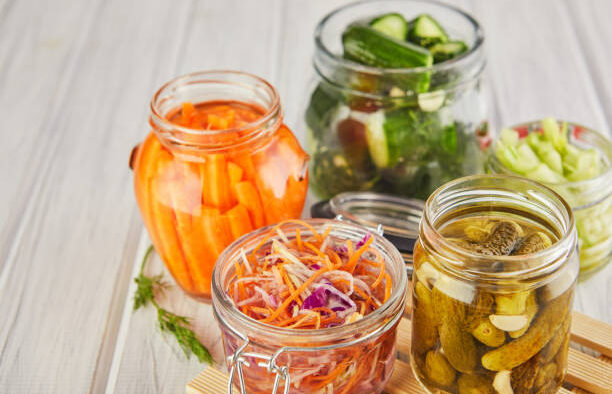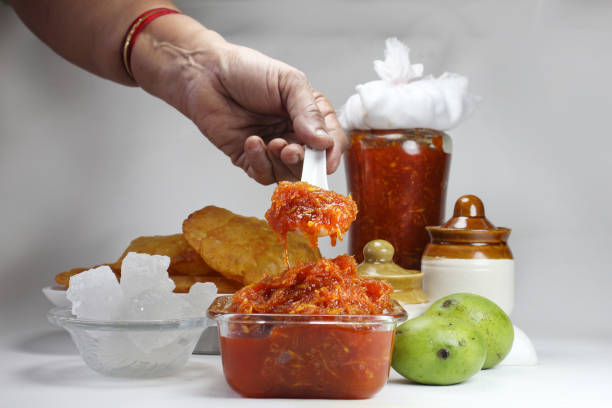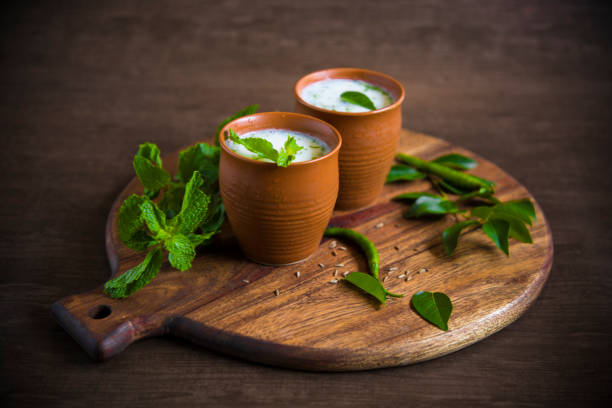As sour is one of the strongest tastes, it is often desired by the palate and becomes a common craving for those seeking stimulation, such as those with cloudy mind, polluted or dulled senses, or those with excess kapha
The rasa experience of each specific food substance is a crucial attribute by which āhāra sustains the human body. Though the term rasa has deeper meanings than the usual translation as taste, the shad-rasa-s generally refer to the six (shad, six, S.) tastes we experience, sweet-sour-salty-pungent-bitter-astringent.
Amla-rasa has the basic material and energies of prithvi (earth) and agni (fire). Foods with naturally sour taste are heavy to digest and unctuous. The most prominent attributes of food articles with natural sour taste is their ushna (heat-producing) and tikshna (penetrating) effects on the body, which attract many people to this flavour, as it also awakens the awareness and stimulates the brain. Sour flavour is associated with strong temptation, as the body instinctively knows it to be a good appetizer and digestive aid.
Consumption of amla-rasa substances stimulates the digestive fire through the dry heat of earth-fire, and also increases the production of saliva and abdominal digestive juices by translating the incoming sour taste with memories and emotions of early experiences and effects of eating sour.
The prithvi component of sour taste induces the quality of good anulomana, which pushes contents of the channels, especially the gut, forward, thus facilitating the movement of faeces down and out. In general, sour articles facilitate digestion for those with low digestive power; hence, they are often utilized as a menu item for people with excess kapha dosha in body (think of excess phlegm, excess moisture, excess fat) such as those having diabetes, obesity, cardiac diseases.

The hot nature of sour taste, however, may aggravate those with pitta dosha disorders, and may even precipate diseases of rakta-dosha such as skin diseases. Substances with amla rasa can be used as part of a nutriment-promoting diet as they endear strength and satisfaction when consumed judiciously.
_______________________________________
अम्लो रसो भक्तं रोचयति, अग्निं दीपयति, देहं बृंहयति ऊर्जयति, मनो बोधयति, इन्द्रियाणि दृढीकरोति, बलं वर्धयति, वातमनुलोमयति, हृदयं तर्पयति, आस्यमास्रावयति, भुक्तमपकर्षयति क्लेदयति जरयति, प्रीणयति, लघुरुष्णः स्निग्धश्च|
Source: Charaka Samhita, Sutra-sthana 26/43.2a
Transliteration: amlō rasō bhaktaṁ rōcayati, agniṁ dīpayati, dēhaṁ br̥ṁhayati ūrjayati, manō bōdhayati, indriyāṇi dr̥ḍhīkarōti, balaṁ vardhayati, vātamanulōmayati, hr̥dayaṁ tarpayati, āsyamāsrāvayati, bhuktamapakarṣayati klēdayati jarayati, prīṇayati, laghuruṣṇaḥ snigdhaśca
Translation: Amla rasa makes food relishing, stimulates agni, enhances body bulk and energizes it, awakens the mind, firms the sense organs, increases bala (strength), causes vatanulomana (normal movement of vata), nourishes the heart, increases secretions in the mouth, propels, moistens, and digests food, gives satisfaction, and is light, hot and unctuous.
**********
Natural sources of amla-rasa include the fruits lime, certain varieties of orange, amalaki (Emblica officinalis), tamarind (Tamarindus indica), and green unripe mango. Dairy products that are fermented also provide natural amla-rasa, such as takra (buttermilk), and dahi (cow curd/yogurt). Other food products with amla-rasa that are prepared include vinegar, kanji (slightly fermented rice cooked in water), and achaars (known as pickles).
These items are sour due to production of citric, malic, oxalic, and tartaric acids in fruits and fermented vegetables. Dairy products such as yogurt and meat products that are preserved are sour due to the presence of lactic acid. All are rich in antioxidants, mainly vitamin C. The rich collection of vitamins, acids and other associated nutrients are thought to be the reason why they are essential parts of the diet.
Sour items improve the digestive ability of our gastrointestinal tract by improving enzyme secretions along with propulsion of excreta forward in lower part of the tract. This is helpful for people with chronic constipation or irritation in the bowel, as both over-dryness or swelling prevent proper function of those muscles lining the tract that help push contents forward in the movement of peristalsis.

Proper evacuation and restoration of the muscles and lining of the tract help with proper digestion and assimilation of nutriments, which allow proper formation of ahara-rasa, which is the essence of food. This in turn improves nourishment to all the dhatu-s (body tissues). Overall nourishment for the body-mind occurs only when clean digestion occurs, and this is why Ayurveda stresses proper appetite, hunger and digestion, which begin with the relishing of food. While today's medical evaluation is based on bio-chemicals in the blood, Ayurveda knew that improved overall health status that is functional and deep is visible with enhanced luster of the body, complexion, and glow of skin, hair, and nails. These are possible when the digestion of high-quality foods is optimal.
The next time you drink a freshly-squeezed glass of orange juice or lime juice, notice how the mild sourness awakens the activity of mind, known as Mano Bodhyati, by polishing the sense organs to be keen and more receptive. The clarity brings deep satisfaction.
_______________________________________
स एवङ्गुणोऽप्येक एवात्यर्थमुपयुज्यमानो दन्तान् हर्षयति, तर्षयति, सम्मीलयत्यक्षिणी, संवेजयति लोमानि, कफं विलापयति, पित्तमभिवर्धयति, रक्तं दूषयति,मांसं विदहति, कायं शिथिलीकरोति, क्षीणक्षतकृशदुर्बलानां श्वयथुमापादयति, अपि च क्षताभिहतदष्टदग्धभग्नशूनप्रच्युतावमूत्रितपरिसर्पितमर्दितच्छिन्नभिन्नविश्लिष्टोद्विद्धोत्पिष्टादीनि पाचयत्याग्नेयस्वभावात्, परिदहति कण्ठमुरो हृदयं च (२)|४३|
Source: Charaka Samhita, Sutra Sthana 26/ 43.2b
Transliteration: sa ēvaṅguṇō'pyēka ēvātyarthamupayujyamānō dantān harṣayati, tarṣayati, sammīlayatyakṣiṇī, saṁvējayati lōmāni, kaphaṁ vilāpayati, pittamabhivardhayati, raktaṁ dūṣayati,māṁsaṁ vidahati, kāyaṁ śithilīkarōti, kṣīṇakṣatakr̥śadurbalānāṁ śvayathumāpādayati, api ca kṣatābhihatadaṣṭadagdhabhagnaśūnapracyutāvamūtritaparisarpitamarditacchin nabhinnaviśliṣṭōdviddhōtpiṣṭādīni pācayatyāgnēyasvabhāvāt, paridahati kaṇṭhamurō hr̥dayaṁ ca|
Translation: This, though endowed with so many qualities, if used singly and excessively, makes teeth sensitive, causes thirst, causes closure of eyes, raises the body hair, liquifies kapha, aggravates pitta, affects blood morbidity, causes inflammation in muscles and laxity in body, produces swelling in wasted, injured, emaciated and debilitated persons, because of its agneya nature causes suppuration in wounds, injuries, bites, burns, fractures, swellings, dislocations, poisoned spots due to urination and contact of insects, compressed, excised, incised, punctured and crushed etc., and causes burning sensation in throat, chest and the cardiac region.
**********
As sour is one of the strongest tastes, it is often desired by the palate and becomes a common craving for those seeking stimulation, such as those with cloudy mind, polluted or dulled senses, or those with excess kapha.
When over-consumed however, sour produces disturbing signs and symptoms of acid toxicity, such as pari-dahati kanthamurohridaya, burning sensation in the mouth, throat and chest; danta-harsa, dentine hypersensitivity of teeth and the gum line; samvejayati lomani, piloerection; and because of increase in heat of the body, excess sour foods may cause trishna, increased thirst. The heat in sour taste liquifies kapha dosha through its sharp nature, but the excess liquid from melting may aggravate respiratory problems such as asthma, bronchitis, and cough.
_______________________________________
तथाऽतिलवणक्षारैरम्लैः कटुभिरेव च ||५||
दध्यम्लमस्तुसुक्तानां सुरासौवीरकस्य च ||७||
शरत्कालस्वभावाच्च शोणितं सम्प्रदुष्यति ||१०|
Source: Charaka Samhita, Sutra Sthana, chap 24, slokas 5,7,10
Transliteration: tathā'tilavaṇakṣārairamlaiḥ kaṭubhirēva ca ||5||
dashyāmlamastu suktānāṁ surāsauvīrakasya ca ||7||
śaratkālasvabhāvācca śōṇitaṁ sampraduṣyati ||10||
Translation: By habitual intake of acidic or pungent foods, liquor/fermented drinks, too much salty, alkaline substances, sour and pungent food, kulatha (Dolichos biflorus), masha (Phaseolus mungo), nishpava (Dolichos lablab), tila taila (Sesamum indicum) sesame oil, pindalu (Randia uliginosa), radish and all green (leafy) vegetables, excessive intake of curd, sour whey (curd-water), vinegars and other sour fermented liquids, consuming decomposed, putrid food with opposite properties excessive sleeping during the day especially after taking liquids, unctuous and heavy food, heat, indigestion, taking meal during indigestion and due to natural pattern in autumn season, one vitiates the blood.
**********
The warm and sharp nature of sour taste when used injudiciously results in increase of pitta dosha, known as pittam abhivardhayan then aggravation. The viscosity of blood is disturbed by increase in pitta dosha that then leads to various diseases, such as kandu (itching), pandu (pallor), visarpa (a subtype of skin disease), vishphota (skin rashes, and jwara (fever). Amla-rasa helps improve the formation of proteins in the body by providing acids that assist in enzymatic reactions, but excess consumption results in breakdown of muscle (catabolism), producing muscular tissue-wasting (maṅsadhatu vidaha), that may further result in sharira shaithilaya (loss of weight and energy and looseness of gripping around the bones). The person can become emaciated and further complications of edema and inflammation may develop in body. The changes in composition of blood in terms of viscosity and other biochemical parameters due to aggravated pitta may give bad prognosis to wounds, burns, fractures or swelling.
Sour foods are vital for a healthy person's daily diet. When consumed, they should be eaten just after having something sweet in the meal or in the early part of the meal. They should always be mindfully consumed by individuals with high pitta prakrti or vikrti, baseline or disease constitution.







